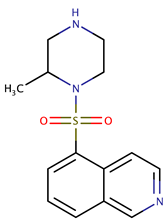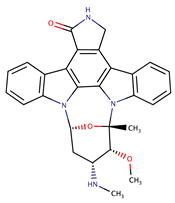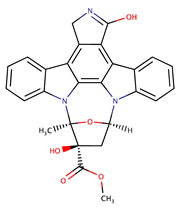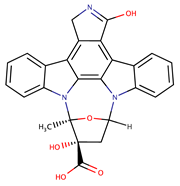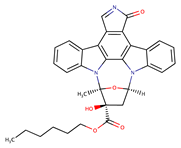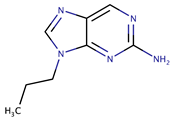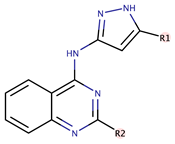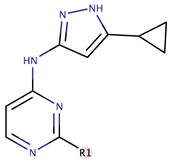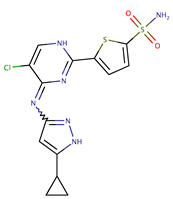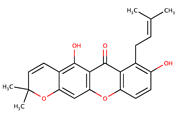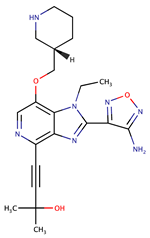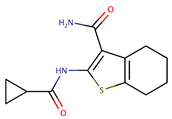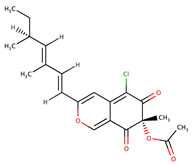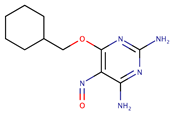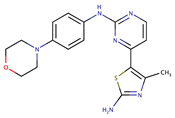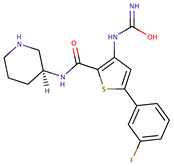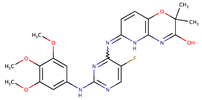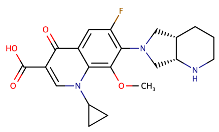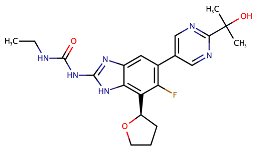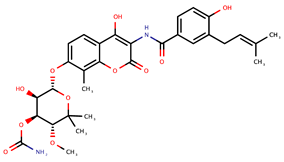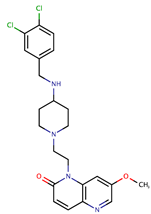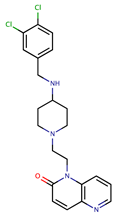Abstract
Structure-based and computer-aided drug design approaches are commonly considered to have been successful in the fields of cancer and antiviral drug discovery but not as much for antibacterial drug development. The search for novel anti-tuberculosis agents is indeed an emblematic example of this trend. Although huge efforts, by consortiums and groups worldwide, dramatically increased the structural coverage of the Mycobacterium tuberculosis proteome, the vast majority of candidate drugs included in clinical trials during the last decade were issued from phenotypic screenings on whole mycobacterial cells. We developed here three selected case studies, i.e., the serine/threonine (Ser/Thr) kinases—protein kinase (Pkn) B and PknG, considered as very promising targets for a long time, and the DNA gyrase of M. tuberculosis, a well-known, pharmacologically validated target. We illustrated some of the challenges that rational, target-based drug discovery programs in tuberculosis (TB) still have to face, and, finally, discussed the perspectives opened by the recent, methodological developments in structural biology and integrative techniques.
1. Introduction
Although the drug discovery process has historically relied on high-throughput screening (HTS) to identify hits to be developed into drug candidates, either on a given target (in most cases, an essential enzyme) or through whole-cell screenings, it still remains an experimentally laborious, expensive, and time-consuming process. Unlike traditional drug discovery, however, drug design is not necessarily based on the screening of large libraries, which is intrinsically a trial and error process, but builds on the available knowledge for a given biological target. A particular, well-known case of drug design is called structure-based drug design (SBDD), which uses the three-dimensional structural knowledge of the target to find or optimize molecules that can bind to the target with high affinity and selectivity. The potential of using structural information for discovering candidate drugs was apparent from the early days of structural biology [1], but it took several years to achieve the first successful examples, i.e., human immunodeficiency virus (HIV) protease inhibitors [2] and carbonic anhydrase inhibitors for the treatment of glaucoma [3].
A three-dimensional model of the target is, therefore, a prerequisite for SBDD. The structure can be obtained experimentally in different ways, in most cases by X-ray crystallography, although nuclear magnetic resonance (NMR) and, more recently, cryo-electron microscopy (cryo-EM) have also attracted attention [4], especially following the spectacular increase in the resolution capabilities of single-particle cryo-EM, which is commonly referred to as the resolution revolution [5,6]. For targets whose experimental structure is elusive, in silico structure prediction is also routinely performed and can be achieved, whenever suitable models are available, through homology modeling from a closely related homologous protein [7].
The identification of potential drug binding sites can be obvious when ligand-bound target structures are available. However, the capability to detect binding sites for substrates or modulators becomes highly relevant not only for targets for which no ligand-bound three-dimensional structure is available, but also to detect allosteric sites or protein–protein interaction surfaces that might be specifically targeted [8], and for these, dedicated libraries are now available [9]. Considering that binding site identification is not always straightforward, tools have been developed to infer “druggable” pockets from the identification of concave regions—that could accommodate drug-size molecules—by screening for appropriate binding properties, such as volume, hydrophobicity, hydrogen bonding, energy potential, solvent accessibility, and desolvation energy [10].
The search for potential ligands on a given target can then follow two different approaches, commonly referred to as ligand-based drug design (LBDD) or target-based drug design (TBDD). LBDD does not require, a priori, direct structural knowledge of the target, but relies on the identification of hits, usually congeneric compounds, with an established biological effect; hit-to-lead optimization can then proceed through the definition of appropriate chemical descriptors of the series, quantitative structure-activity relationship analysis (QSAR), and pharmacophore modeling [11], all followed by experimental validation. QSAR-based virtual screening approaches, alone or in combination with HTS screenings, can also be used to enlarge the panel of bioactive compounds against the target or pathway of interest, increasing the overall hit rate [12]. TBDD, in contrast, uses the physical-chemical constrains from the target three-dimensional structure, and possibly a well-defined binding pocket, to perform virtual screening of libraries, either of natural or synthetic compounds, usually applying appropriate filters like compliance to Lipinski’s rules or QSAR models, or to design molecules de novo in a step-wise manner. A particular case of de novo molecule design is fragment-based drug design (FBDD), in which low-affinity target binding molecules are identified from appropriate libraries, using a variety of biophysical approaches, and then merged or linked together using the available three-dimensional information to achieve larger binders with improved properties [13,14].
It is common knowledge in the field that although SBDD approaches have proven to be successful for non-transmissible diseases and viral diseases, they have proven to be much less effective in the antibiotic discovery field [15,16]. Unfortunately, tuberculosis represents no exception to this trend [17], despite the considerable progress achieved during the last twenty years in the understanding of the pathogen molecular physiology, starting from the seminal publication of the M. tuberculosis genome sequence in 1998 [18], the extensive structural genomics campaigns during the following years [19,20,21], the advances in understanding host-pathogen interactions and the development of the disease [22,23], and notwithstanding the development of genetic and biochemical tools to allow the in vivo and in vitro validation of targets [24,25].
The purpose of this review was not to provide an exhaustive overview of the capabilities now offered by in silico approaches for antibiotic development against M. tuberculosis, already reviewed elsewhere [26,27], nor to make a survey of the current state of structural knowledge of the pathogen proteome and the experimental structures relevant for drug discovery, for which we point the reader to very recent, extensive work [28]. Rather, we focused here on three emblematic case studies of M. tuberculosis targets that attracted most efforts for anti-tuberculosis compound development by HTS campaigns, computer-aided, and structure-driven compound identification: the serine/threonine (Ser/Thr) kinases—protein kinase (Pkn)B and PknG—two amongst the most known, supposedly promising new targets offered by the post-genomic era, and the DNA gyrase, the ‘old’ but the well-proven target of fluoroquinolones.
2. Protein Ser/Thr Kinases as Drug Targets
Protein phosphorylation is a well-known, widespread mechanism for signal transduction and regulation of several biological functions. Protein kinases have long been known as major drug targets [29], especially for the treatment of cancer, where the deregulation of signaling mechanisms is a hallmark of the disease [30]. Protein kinases are not only pharmaceutical targets in cancer chemotherapy but also for the treatment of parasitic infections, ranging from the ones caused by Trypanosomatids or Leishmania [31] to malaria [32]. Since the sequence of M. tuberculosis H37Rv genome was first reported in 1998 [18], the pathogen has been known to possess eleven genes coding for Hanks-type Ser/Thr kinases [33], named from pknA to pknL (but no pknC), providing one of the first challenges to the paradigm of prokaryotic cell signaling as being entirely driven by two-component systems. One gene coding for a transmembrane Ser/Thr phosphatase, pstP, was also identified as lying on the same cluster as pknA and pknB, forming a putative operon [34], in addition to two genes (ptpA and ptpB) coding for Tyr phosphatases [35]. Nine out of eleven Ser/Thr kinases (all but PknG and PknK) were predicted to be integral membrane proteins, all sharing the same topology with an N-terminal catalytic domain in which the archetypal Hanks motifs could be identified [33], a single transmembrane segment and a very variable extracellular, C-terminal domain, hypothesized to be acting as a signal sensing domain. The role of such C-terminal domains is, in most cases, still puzzling, although, in some kinases like PknB, it has been suggested to be involved in the kinase activation process, possibly by controlling the kinase oligomerization state as a function of the external signal [36]. Work from Tom Alber’s group in Berkeley indeed demonstrated the role of the ‘back-to-back’ dimerization to promote an active kinase conformation, not only for PknB [37,38] but also for PknD [39], notwithstanding the observation that mutations in the dimerization interface do not abolish kinase activity, as reported by separate groups [37,40]. PknB was also the first M. tuberculosis kinase for which the crystal structure of the catalytic domain was described in 2003 [41,42]. Indeed, this first crystal structure confirmed the overall conservation of the bi-lobed protein kinase fold and the initial assumptions about the presence of the known structural features of eukaryotic protein kinases, as predicted by the detection of the Hanks motifs [42], thus underlining the common origin of eukaryotic and prokaryotic kinases. Following these first milestones and the genetic proof of the in vitro essentiality of pknB coming both from transposon mutagenesis [43] and targeted studies [44,45], PknB then attracted the attention of tuberculosis (TB) research community as an ideal target for structure-based drug design. The community’s interest rise when considering the increasing evidence, over the years, of its role in the control of peptidoglycan synthesis and cell division (recently reviewed in [46]). The first description of the potential use of PknB inhibitors as anti-mycobacterial agents reported the compound H-7 (1-(5-isoquinolinesulfonyl)-2-methylpiperazine; Table 1), well before any bacterial protein kinase structure was available [47]. Once the PknB catalytic domain structure was solved, virtual screening carried out on a library of about 40,000 compounds for hits into the PknB adenosine triphosphate-binding (ATP-binding) pocket was performed. The screening led to identifying mitoxantrone, a chemotherapeutic agent known for its DNA intercalating properties, as a sub-micromolar PknB inhibitor [48], similar to staurosporine, K-252-a, and K-252-b (Table 1), who were identified as hits after testing a few commercially available eukaryotic kinase inhibitors [44]. The crystal structure of the PknB-mitoxantrone complex was the first showing the kinase catalytic domain in complex with a non-ATP analog, kinase inhibitor. Two crucial, hydrogen bonding interactions were evidenced between the mitoxantrone hydroxyl groups and main chain atoms from the PknB hinge region that connects the two kinase lobes, i.e., the carbonyl oxygen of Glu93 and the amino group of Val95 [48], opening the way to compound optimization (Figure 1A,B). Several other PknB inhibitors were proposed in the course of the following years, starting from hits developed either from known kinase inhibitors like staurosporine analogs [37], 2-aminopurine and its derivatives, including organometallic compounds [49]), or from hits obtained from HTS on public or proprietary libraries using GarA as the substrate [50,51,52,53], or phytocompounds [54] (Table 1). Most of the published work deals with compounds inhibiting the kinase in the micro and sub-micromolar range but with limited activity on mycobacteria. The exception to this trend is IMB-YH-8 (Table 1), a compound that, despite showing an IC50 (half maximal inhibitory concentration) on PknB in the 20 µM range, shows good selectivity for mycobacterial PknB and PknA and a MIC (minimal inhibitory concentration) in the sub-micromolar range [53]. Compounds highly active on both PknB and PknA have also been reported recently by others in the form of substituted quinazolines, and, for a compound derived from this series (a pyrimidine analog), the crystal structures of the respective complexes with both kinases have been described [55] (Figure 1, Table 1). Both structures underline the common binding mode in the ATP pocket and the crucial interaction with the hinge region (Figure 1B). Despite the inhibition constant for both kinases falls in the nanomolar range, these dual-targeting inhibitors display promising but yet limited antibacterial effect with MIC on M. tuberculosis in the lower micromolar range [55]. A different PknB inhibitor for which a crystal structure in complex with the target is available is GSK690693 (Figure 1C, Table 1), also identified through a virtual screening approach on known kinase inhibitors [56]. This compound, member of the imidazopyridine aminofurazans class, also displays conserved features in its binding mode to the PknB hinge region (Figure 1B), and sub-micromolar affinity to the kinase, but no significant antimycobacterial activity on Mycobacterium smegmatis or Mycobacterium bovis BCG (bacillus Calmette-Guerin). However, the MIC is significantly lowered if the compound is associated with a sub-MIC50 concentration of meropenem, suggesting a synergistic action between PknB inhibitors and β-lactams [56].

Table 1.
M. tuberculosis PknB inhibitors.
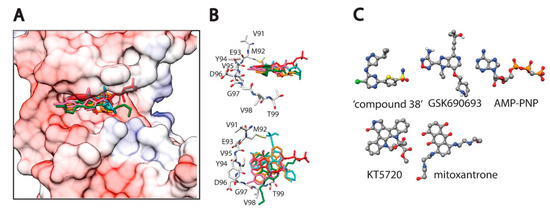
Figure 1.
Experimental structures of protein kinase B (PknB)-inhibitor complexes. (A) Electrostatic surface from the X-ray structure of PknB in complex with AMP-PCP (β,γ-methyleneadenosine 5′-triphosphate) in red (pdb: 1O6Y), superimposed with the coordinates of four other PknB complexes with, respectively, mitoxantrone in green (pdb: 2FUM), KT5720 in orange (pdb: 3F69), GSK690693 in cyan (pdb: 5U94), and ‘compound 38’ in pink (pdb: 6B2P). This compound has been reported as active on both PknA and PknB [55]. (B) Side and top view of the superimposed ligands with the hinge region from the pdb entry 6B2P. Kinase residues are indicated. (C) Ball-and-stick representation of the ligands kept in the same relative binding orientation as in (B) and colored by element.
On the other hand, another M. tuberculosis kinase that attracted as much attention for its potential druggability is PknG, a soluble Ser/Thr kinase that was described, by Jean Pieters and coworkers, as a virulence factor secreted into the human macrophage, where it would inhibit the phagosome-lysosome fusion [57]. Most notably, in the same work, the authors showed that chemical inhibition of PknG by the compound AX20017 (a tetrahydrobenzothiophene identified by HTS and found to inhibit PknG with IC50 in the sub-micromolar range; Table 2) led to the accumulation of M. tuberculosis inside lysosomes [57]. Noteworthy, the 2.4 Å resolution crystal structure of an N-terminal truncated form of PknG in complex with AX20017, published later [58], shows a great similarity between the AX20017 binding to PknG and the binding of ATP and mitoxantrone to PknB. Not only the compound occupies the adenine binding pocket but also makes similar interactions with the main chain atoms of residues Glu233 and Val235 (Figure 1). It was only a few years later that further structural work allowed to elucidate the binding mode of ATP to PknG and suggested a regulatory role of the rubredoxin-like domain by a reversible occlusion of the active site entrance [59]. These initial findings paved the way to further structure-based lead optimization and undoubtedly generated excitement for the potential chemical targeting of this kinase, which would allow preventing the arrest of phagosome maturation, directing M. tuberculosis to lysosomes. Attempts to develop more potent compounds starting from AX20017 yielded sub-micromolar inhibitors, some of which had no activity in macrophage assays [50], and no other structure of a PknG-inhibitor complex has so far been reported. It is, however, worth noting that, more than ten years later, the role of PknG in arresting the phagosome maturation is still elusive. Although progress has been made in identifying the SecA2 system as responsible for the export of PknG outside M. tuberculosis [60,61], and interference by PknG on the host Rab7l1 signaling pathway has been reported [62], it is largely accepted that several mechanisms, and not a single virulence factor, contribute to the M. tuberculosis capability to escape the phagocytic route and survive into macrophages [22,63]. Moreover, an increasing amount of evidence has since validated PknG as a key signaling element in the control of central metabolism, as first shown in Corynebacterium glutamicum [64,65], then in mycobacteria [66,67], where genetic and metabolomic evidence point to a role of PknG in regulating the 2-oxoglutarate node according to nutrient availability [68]. Alternative roles of PknG in biofilm formation, adaptation to oxidative stress [69], and hypoxia [70] have also been proposed. Therefore, the observed effects of the lack of PknG on the phagosome-lysosome fusion, and the decreased viability of a pknG-deprived M. tuberculosis mutant, both in vitro and in the mouse model [71], may not necessarily indicate a direct interference of the kinase on the host signaling pathways but could be ascribed to metabolic alterations caused by the depletion of PknG [68,72]. During the last years, further search for PknG inhibitors has allowed identifying sclerotiorin, an azaphilone derivative isolated from Penicillium sp. ZJ27 (Table 2), a known inhibitor of other unrelated enzymes like lipoxygenase, that, despite showing an IC50 on PknG around 76 µM and no inhibition on M. tuberculosis growth in vitro, displays capability to partially reduce the growth of Mycobacterium bovis BCG inside macrophages, and to enhance the effect of rifampicin [73]. On the other hand, the recently described PknG inhibitor NU-6027 (2,6-diamino-4-cyclohexylmethoxy-5-nitrosopyrimidine; Table 2) was identified from phenotypic screening as having an MIC99 value of 1.56 μM on M. bovis BCG and shown to partially inhibit PknG and PknD autophosphorylation in vitro [74]. Another series of four compounds, all inhibiting PknG in the micromolar range, was also recently reported after the screening of an 80-compound, commercially available kinase inhibitor library (Table 2); three of them were found to promote the transfer of mycobacteria to lysosomes, and two to inhibit M. bovis BCG growth in macrophages [75]. None of the reported compounds, however, issued from a structure-based screening approach.

Table 2.
M. tuberculosis PknG inhibitors.
3. DNA Gyrase: A Validated Drug Target
Topoisomerases are enzymes that participate in the overwinding or underwinding of DNA. They are commonly split into two classes, depending on the number of DNA strands cut during a single catalysis cycle: class I topoisomerases, which include eukaryotic topoisomerase I, prokaryotic topoisomerase IIIa, or reverse gyrase among others, and class II topoisomerases, whose members include (but are not restricted to) topoisomerase IV and DNA gyrase [76]. In M. tuberculosis, DNA gyrase is a heterotetrameric nanomachine, consisting of two GyrB and two GyrA subunits, and is essential for DNA replication, transcription, and repair in living cells [77].
M. tuberculosis is an exception in the prokaryotic world because of the presence of only one type I and one type II topoisomerase, whereas most other eubacteria have two enzymes of each type. In the canonical situation, DNA gyrase and topoisomerase IV, both type IIA topoisomerases, have distinct specific activities: DNA gyrase removes positive supercoils that accumulate ahead of replication forks [78], whereas topoisomerase IV decatenates replication intermediates [79]. Thus, in M. tuberculosis, DNA gyrase being the unique topoisomerase IIA, it must be able to carry out both activities in vivo [80]. Furthermore, with no other topoisomerase IIA in M. tuberculosis, the DNA gyrase is the unique target of antibiotics from the fluoroquinolones (FQ) family (quinolones with higher cellular penetration efficiency), which bind and stabilize the DNA–DNA gyrase complex. Stabilization of this ternary complex leads to the cytotoxic accumulation of double-strand cleaved DNA fragments within the cell, inducing bacterial death [81]. Crystallographic structures of the isolated domain and the cleavage core, either in its apo form or co-crystallized with several FQ, brought crucial information to elucidate the mode of binding of these drugs [82,83,84,85,86,87]. The ratio FQ/DNA–DNA gyrase in the ternary complex is two FQ molecules per complex, with one molecule binding in each cleavage site, wedging between the two ends of the cleaved DNA strands on both halves of the complex, in a drug-binding pocket whose walls are formed by DNA base stacking (Figure 2A) [82]. The emergence of strains with multidrug resistance (MDR) phenotype, or extensively-drug resistance (XDR) phenotype in which drug resistance includes this family of antibiotics, has made improving the activity of this family of drugs by using structural data to be of utmost importance. The main goals of these studies are to increase specific drug/enzyme interactions, but also to find new molecules that inhibit this validated target without cross-resistance with FQ [88].
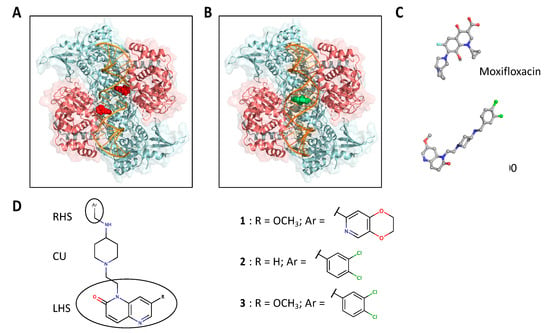
Figure 2.
Inhibitors of DNA gyrase. (A) Top view of the X-ray structure of M. tuberculosis gyrase cleavage core in complex with DNA and moxifloxacin. Protein is shown in cartoon representation with transparent surfaces, with GyrB in blue and GyrA in pink. DNA is shown in orange, with moxifloxacin as red spheres (pdb: 5BS8). (B) Top view of the model of a complex of GSK000 (green spheres) with M. tuberculosis gyrase cleavage core and uncleaved DNA (in orange), based on the crystal structure of GSK299423 with Staphylococcus aureus gyrase (pdb: 2XCR). The same representation, as in panel A, was used for the protein. (C) Ball-and-stick representation of the ligands colored by element. (D) Generic chemical structure of the novel bacterial topoisomerase inhibitor (NBTI) series of compounds. Analog 1 is a classical NBTI, whereas analogs 2 and 3 combine the three favorable features for M. tuberculosis DNA gyrase inhibitor (MGI).
A significant amount of effort has thus been invested in discovering new M. tuberculosis gyrase inhibitors, mostly centered on the ATP- and DNA-binding sites, and particularly using in silico methods based on the emerging gyrase structural information, as extensively reviewed by Nagaraja and coworkers [89]. Although the ATP binding sites have been less successfully exploited as antibacterial targets, with the exception of the natural products, such as coumarins [90,91], it is worth noting that a candidate drug emerged from these studies. SPR720 (Table 3) is an orally bioavailable prodrug of SPR719, an aminobenzimidazole inhibitor of both gyrase and topoisomerase IV. Indeed, this novel class of antimicrobials targets the ATPase subunits of gyrase and topoisomerase IV, and it was optimized using SSBD and structure-activity relationship (SAR) studies of potency against both Gram-positive and some Gram-negative bacterial species [92,93]. Crystal structures of novobiocin (Table 3) bound to Escherichia coli GyrB subunit served as a starting point for ligand optimization [94], while further optimization of the metabolic profile led to the identification of SPR720 (formerly VXc-486) [95], whose suitability to be a drug candidate for the treatment of tuberculosis and non-tuberculosis mycobacterial infections was thoroughly evaluated [96,97]. The compound completed Phase I clinical trials in 2019 (study ID NCT03796910, sponsored by Spero Therapeutics, LLC), aimed at evaluating the safety, tolerability, and pharmacokinetics (PK) profile in healthy volunteers. Moreover, an in vivo combination of SPR720 with rifampicin and pyrazinamide (two first-line drugs used in TB treatment) showed comparable efficacy to the combination of three drugs, including moxifloxacin, rifampicin, and pyrazinamide [98].

Table 3.
M. tuberculosis DNA gyrase inhibitors.
Work on the DNA-binding site has also been productive, as GlaxoSmithKline (GSK) created a new class of type IIA topoisomerase inhibitors, called novel bacterial topoisomerase inhibitors (NBTIs) (Table 3) [99]. The crystallographic structures of the DNA-bound Staphylococcus aureus DNA gyrase with either NBTI or FQ, all obtained at high resolution, revealed that the binding sites for each drug are different [100]. Indeed, the NBTI ‘bridges’ the DNA and a transient non-catalytic pocket on the two-fold axis at the GyrA dimer interface, remaining close to the active sites and FQs binding sites (Figure 2B). As NBTIs display relatively poor activity against the M. tuberculosis DNA gyrase, the antitubercular profiles of 3000 compounds, representative of the chemical diversity of this family, were evaluated by high-throughput phenotypic screenings in vitro and in vivo [101]. MIC determination on M. tuberculosis H37Rv showed a high hit rate (68% of compounds with MIC values lower than 10 μM), with the most potent derivatives matching or even improving the MIC values for currently used TB drugs, including last-generation FQs. Overall, 29% of the compounds had MICs of < 1 μM, and 18% had MICs of < 0.1 μM. By using structural data provided by the work of Bax et al., the general structures of these TB-active compounds were divided into three different regions, each of them interacting with one of the three topologically important target-gyrase interacting regions [100]. While a left-hand side (LHS) is responsible for key contacts with the gyrase DNA substrate, a right-hand side (RHS) is embedded into the enzyme, potentially contributing to the protein target selectivity (Figure 2D). Last, a central linker unit (CU) establishes key interactions with the gyrase and offers the opportunity to modulate key physicochemical properties (Figure 2D). These SAR observations helped to schematize synthesis and to rationalize how to balance antimycobacterial potency with oral exposure, safety, and synthetic complexity, leading to the identification of the 7-substituted-1,5-naphthyridin-2-one core as a privileged LHS binder, the N-ethyl-4-aminopiperidines as a linker, and monocyclic aromatic rings with different substitution patterns as the best RHS binding option, in contrast to NBTIs bearing bicyclic rings as the RHS (Figure 2D, analogs 2 and 3) [101]. This work led to the identification of a subclass of naphthytidone/aminopiperidine-containing compounds that displayed activity against M. tuberculosis, both in vitro and in the mouse model, known as ‘M. tuberculosis DNA gyrase inhibitors’ (MGIs) due to structural and activity differences with respect to NBTIs [101]. More recently, the mechanism of action of two such compounds, i.e., GSK000 and GSK325 (Figure 2C; Table 3), was assessed on the M. tuberculosis gyrase, showing that MGIs greatly enhanced DNA cleavage mediated by the bacterial enzyme, but they induced only single-stranded DNA breaks [102]. Their mechanism of action involves stabilizing covalent gyrase-cleaved DNA complexes and appears to suppress the ability of the enzyme to induce double-stranded breaks. Furthermore, these compounds maintained activity against mutant versions of DNA gyrase, bearing the three most commonly observed FQs resistance mutations, but displayed no activity against human topoisomerase IIα [102], suggesting good potential as candidate drugs, especially in the presence of FQ resistance. Modeling studies were carried out by the authors using the crystal structure of the M. tuberculosis gyrase cleavage core and the NBTI crystal structure complex of S. aureus gyrase [100] (Figure 2B). Most importantly, these studies allowed to confirm that FQs and MGIs do not share the same binding site and bind in a mutually exclusive manner (Figure 2), considerably reducing the risk of developing cross-resistance phenotypes.
4. General Remarks
Several challenges need to be overcome for therapeutic molecules to be active against M. tuberculosis. Due to its metabolic adaptability and its known capabilities to occupy different niches inside the human host, from free aerobic bacteria to granulomas, an ideal molecule should be able to act against bacteria in very different, environmentally adapted states. The unique structure and composition of the M. tuberculosis cell wall are also well known to act as a barrier for potentially active compounds. To be active against latent and active infections, an ideal drug candidate should thus be able to reach bacteria in all the tubercular lesions and niches inside the human host [103], permeate the mycobacterial cell wall or be actively internalized, and deliver the desired bioactivity in bacteria under different metabolic states. To overcome these limitations and reduce the risk of further resistance development, TB drugs are delivered in combinations, starting from the standard DOTS (directly observed therapy short-course). Drug combinations, however, have to take in due account the bioavailability and pharmacokinetic properties of the single components and their associations, as extensively treated in this same journal issue [104].
In the course of the last ten years, it has become increasingly clear that some of the criteria commonly used to classify a given M. tuberculosis biological process, in many cases, an enzymatic step in a pathway, as a ‘good’ target for drug development, needed to be revised. This is particularly true for in vitro genetic essentiality. Even targets confirmed to be essential by the construction of specific conditional mutants do not necessarily show a good ‘druggability’, even when highly potent hits become available. The case of PknB is an emblematic example: despite the gene was early shown to be essential for M. tuberculosis growth, first by transposon mutagenesis [43], then through attempts to generate a knock-out mutant [44], yet several research groups, including ours, had to face the problem of the lack of correlation between hit potency in vitro and efficacy in vivo [50,51,52]. Similar issues were also reported for other M. tuberculosis kinase inhibitors, in addition to the cross-reactivity sometimes reported towards eukaryotic kinases, and the cytotoxicity shown by some compounds on human cell lines [105]. In addition, although the availability of crystal structures of both PknB and PknG in complex with hits issued from medium-throughput screens (mitoxantrone and AX20017, respectively) has looked as a promising ‘proof-of-concept’ [48,58], further structure-based work on these kinases has, so far, failed to produce suitable drug candidates. Many reasons might be evoked to explain the lack of M. tuberculosis kinase inhibitors that display significant antibacterial activity, ranging from the poor capacity to penetrate the mycobacterial cell and reach their target to the kinase redundancy in M. tuberculosis and their, relatively poor, substrate specificity [46], which prompted groups to seek for multiple kinase inhibition [105]. Yet, the main causes should perhaps be looked for in our, still limited, knowledge of mycobacterial molecular physiology and the regulatory networks in M. tuberculosis, in which Ser/Thr kinases are actors of a complex interplay [46,106]. Indeed, the activation mechanisms of both PknB and PknG are still a matter of speculation, and changes to pknB expression, either as depletion or overexpression, have been reported to alter the bacterial growth significantly [34]. Given the known M. tuberculosis metabolic plasticity, whose complexity has only recently started to be elucidated, thanks to the development of genetic and ‘omics’ tools [107], and the adaptability of the pathogen in the course of infection, it is now largely accepted that genetic essentiality of a putative target in laboratory conditions is not necessarily an indication of chemical vulnerability [15], and even more in clinical conditions. For these reasons, phenotypic screens have increasingly been employed in TB drug development to the detriment of target and structure-based methods, including for lead optimization [15], and the vast majority of candidate TB drugs that have been able to enter clinical trials in the last years were issued from this kind of screens [17,108].
Nevertheless, structure-based and computer-aided drug design maintain a clear potential for the future development of new anti-tubercular drug candidates. For instance, a recent, very promising success of structure-based and fragment-based approaches in TB drug discovery is the development of the so-called ethionamide boosters directed against the EthR repressor, one of which has been shown to be active both in vitro and in vivo [109]. In addition, the recent developments in X-ray crystallography [110], cryo-EM [4], and integrative structural biology methods [111] will all contribute to increasing the number of tools available to tackle the challenges that lay ahead. These opportunities are well exemplified by the case of mycobacterial DNA gyrase that, considering our capacity to obtain high-resolution structures of an almost full-length form of the M. tuberculosis enzyme [112], and the recent, high-resolution cryo-EM structure of E. coli gyrase in complex with NBTI [113], let us believe that SBDD will deliver a key contribution to developing new compounds against this ‘old’ but validated target. High-resolution snapshots of the complete mycobacterial gyrase machinery, especially if in complex with representative members of each known family of inhibitors, might revolutionize our knowledge of this key target and substantially increase chances of improving our therapeutic bullets. For instance, combining crystallographic and cryo-EM data could allow to perform structure-guided drug design to target these flexible complexes and identify new conformations of mycobacterial gyrase that could not, otherwise, be obtained by conventional structural methods. More generally, the integration of biophysical and structural biology data, with the notable contribution of high-resolution EM, will allow the drug discovery pipelines to work on a higher complexity level that was previously not achievable, now looking at targets in their larger biological context (e.g., complexes or cellular compartments). It is, therefore, foreseeable that, despite the technical challenges, target-based and structure-based approaches will have increasing relevance in future drug discovery and will give significant contributions in the search for new tuberculosis drugs.
Author Contributions
All authors contributed to conceptualization, the preparation of the draft, and the review of this work. All authors have read and agreed to the published version of the manuscript.
Funding
This work was partially supported by institutional grants from the Institut Pasteur and the CNRS.
Acknowledgments
We are grateful to all our past and present colleagues from the Structural Microbiology Unit, as well as collaborators from the former MM4TB Consortium, for so many fruitful exchanges and insightful discussions.
Conflicts of Interest
The authors declare no conflict of interest.
References
- Perutz, M.F. Fundamental research in molecular biology: Relevance to medicine. Nature 1976, 262, 449–453. [Google Scholar] [CrossRef] [PubMed]
- Wlodawer, A. Rational approach to AIDS drug design through structural biology. Annu. Rev. Med. 2002, 53, 595–614. [Google Scholar] [CrossRef] [PubMed]
- Greer, J.; Erickson, J.W.; Baldwin, J.J.; Varney, M.D. Application of the three-dimensional structures of protein target molecules in structure-based drug design. J. Med. Chem. 1994, 37, 1035–1054. [Google Scholar] [CrossRef] [PubMed]
- Renaud, J.-P.; Chari, A.; Ciferri, C.; Liu, W.-T.; Rémigy, H.-W.; Stark, H.; Wiesmann, C. Cryo-EM in drug discovery: Achievements, limitations and prospects. Nat. Rev. Drug. Discov. 2018, 17, 471–492. [Google Scholar] [CrossRef] [PubMed]
- Kuehlbrandt, W. The Resolution Revolution. Science 2014, 343, 1443–1444. [Google Scholar] [CrossRef]
- Mitra, A.K. Visualization of biological macromolecules at near-atomic resolution: Cryo-electron microscopy comes of age. Acta Crystallogr. F Struct. Biol. Commun. 2019, 75, 3–11. [Google Scholar] [CrossRef]
- Muhammed, M.T.; Aki-Yalcin, E. Homology modeling in drug discovery: Overview, current applications, and future perspectives. Chem. Biol. Drug. Des. 2019, 93, 12–20. [Google Scholar] [CrossRef]
- Kuenemann, M.A.; Sperandio, O.; Labbé, C.M.; Lagorce, D.; Miteva, M.A.; Villoutreix, B.O. In silico design of low molecular weight protein-protein interaction inhibitors: Overall concept and recent advances. Prog. Biophys. Mol. Biol. 2015, 119, 20–32. [Google Scholar] [CrossRef]
- Bosc, N.; Muller, C.; Hoffer, L.; Lagorce, D.; Bourg, S.; Derviaux, C.; Gourdel, M.-E.; Rain, J.-C.; Miller, T.W.; Villoutreix, B.O.; et al. Fr-PPIChem: An academic compound library dedicated to protein–protein interactions. ACS Chem. Biol. 2020. [Google Scholar] [CrossRef]
- Yuan, Y.; Pei, J.; Lai, L. Binding site detection and druggability prediction of protein targets for structure-based drug design. Curr. Pharm. Des. 2013, 19, 2326–2333. [Google Scholar] [CrossRef]
- Acharya, C.; Coop, A.; Polli, J.E.; Mackerell, A.D. Recent advances in ligand-based drug design: Relevance and utility of the conformationally sampled pharmacophore approach. Curr. Comput. Aided. Drug. Des. 2011, 7, 10–22. [Google Scholar] [CrossRef] [PubMed]
- Neves, B.J.; Braga, R.C.; Melo-Filho, C.C.; Moreira-Filho, J.T.; Muratov, E.N.; Andrade, C.H. QSAR-based virtual screening: Advances and applications in drug discovery. Front. Pharmacol. 2018, 9, 1275. [Google Scholar] [CrossRef] [PubMed]
- Davis, B.J.; Hubbard, R.E. Fragment-Based Ligand Discovery. In Structural Biology in Drug Discovery Methods, Techniques, and Practices; Renaud, J.-P., Ed.; Wiley: Hoboken, NJ, USA, 2020; Volume 10, pp. 79–98. [Google Scholar]
- Mendes, V.; Blundell, T.L. Targeting tuberculosis using structure-guided fragment-based drug design. Drug Discov. Today 2017, 22, 546–554. [Google Scholar] [CrossRef] [PubMed]
- Kana, B.D.; Karakousis, P.C.; Parish, T.; Dick, T. Future target-based drug discovery for tuberculosis? Tuberculosis 2014, 94, 551–556. [Google Scholar] [CrossRef] [PubMed]
- Payne, D.J.; Gwynn, M.N.; Holmes, D.J.; Pompliano, D.L. Drugs for bad bugs: Confronting the challenges of antibacterial discovery. Nat. Rev. Drug Discov. 2007, 6, 29–40. [Google Scholar] [CrossRef] [PubMed]
- Koul, A.; Arnoult, E.; Lounis, N.; Guillemont, J.; Andries, K. The challenge of new drug discovery for tuberculosis. Nature 2011, 469, 483–490. [Google Scholar] [CrossRef]
- Cole, S.T.; Brosch, R.; Parkhill, J.; Garnier, T.; Churcher, C.; Harris, D.; Gordon, S.V.; Eiglmeier, K.; Gas, S.; Barry, C.E.; et al. Deciphering the biology of Mycobacterium tuberculosis from the complete genome sequence. Nature 1998, 393, 537–544. [Google Scholar] [CrossRef]
- Holton, S.J.; Weiss, M.S.; Tucker, P.A.; Wilmanns, M. Structure-based approaches to drug discovery against tuberculosis. Curr. Protein Pept. Sci. 2007, 8, 365–375. [Google Scholar] [CrossRef]
- Terwilliger, T.C.; Park, M.S.; Waldo, G.S.; Berendzen, J.; Hung, L.W.; Kim, C.Y.; Smith, C.V.; Sacchettini, J.C.; Bellinzoni, M.; Bossi, R.; et al. The TB structural genomics consortium: A resource for Mycobacterium tuberculosis biology. Tuberculosis 2003, 83, 223–249. [Google Scholar] [CrossRef]
- Ehebauer, M.T.; Wilmanns, M. The progress made in determining the Mycobacterium tuberculosis structural proteome. Proteomics 2011, 11, 3128–3133. [Google Scholar] [CrossRef]
- Huang, L.; Nazarova, E.V.; Russell, D.G. Mycobacterium tuberculosis: Bacterial Fitness within the Host Macrophage. Microbiol. Spectr. 2019, 7, PMC6459685. [Google Scholar] [CrossRef] [PubMed]
- Sia, J.K.; Rengarajan, J. Immunology of Mycobacterium tuberculosis Infections. Microbiol. Spectr. 2019, 7, PMC6636855. [Google Scholar] [CrossRef] [PubMed]
- Woong Park, S.; Klotzsche, M.; Wilson, D.J.; Boshoff, H.I.; Eoh, H.; Manjunatha, U.; Blumenthal, A.; Rhee, K.; Barry, C.E.; Aldrich, C.C.; et al. Evaluating the sensitivity of Mycobacterium tuberculosis to biotin deprivation using regulated gene expression. PLoS Pathog. 2011, 7, e1002264. [Google Scholar] [CrossRef]
- Wei, J.-R.; Krishnamoorthy, V.; Murphy, K.; Kim, J.-H.; Schnappinger, D.; Alber, T.; Sassetti, C.M.; Rhee, K.Y.; Rubin, E.J. Depletion of antibiotic targets has widely varying effects on growth. Proc. Natl. Acad. Sci. USA 2011, 108, 4176–4181. [Google Scholar] [CrossRef]
- Aleksandrov, A.; Myllykallio, H. Advances and challenges in drug design against tuberculosis: Application of in silico approaches. Expert Opin. Drug Discov.. 2019, 14, 35–46. [Google Scholar] [CrossRef] [PubMed]
- Waman, V.P.; Vedithi, S.C.; Thomas, S.E.; Bannerman, B.P.; Munir, A.; Skwark, M.J.; Malhotra, S.; Blundell, T.L. Mycobacterial genomics and structural bioinformatics: Opportunities and challenges in drug discovery. Emerg. Microbes Infect. 2019, 8, 109–118. [Google Scholar] [CrossRef]
- Pedelacq, J.D.; Nguyen, M.C.; Terwilliger, T.C.; Mourey, L. A Comprehensive Review on Mycobacterium tuberculosis Targets and Drug Development from a Structural Perspective. In Structural Biology in Drug Discovery Methods, Techniques, and Practices; Renaud, J.-P., Ed.; Wiley: Hoboken, NJ, USA, 2020; Volume 3, pp. 545–566. [Google Scholar]
- Cohen, P. Protein kinases--the major drug targets of the twenty-first century? Nat. Rev. Drug Discov. 2002, 1, 309–315. [Google Scholar] [CrossRef]
- Knapp, S. New opportunities for kinase drug repurposing and target discovery. Br. J. Cancer 2018, 118, 936–937. [Google Scholar] [CrossRef]
- Schoijet, A.C.; Sternlieb, T.; Alonso, G.D. Signal Transduction Pathways as Therapeutic Target for Chagas Disease. Curr. Med. Chem. 2019, 26, 6572–6589. [Google Scholar] [CrossRef]
- Lima, M.N.N.; Cassiano, G.C.; Tomaz, K.C.P.; Silva, A.C.; Sousa, B.K.P.; Ferreira, L.T.; Tavella, T.A.; Calit, J.; Bargieri, D.Y.; Neves, B.J.; et al. Integrative Multi-Kinase Approach for the Identification of Potent Antiplasmodial Hits. Front. Chem. 2019, 7, 773. [Google Scholar] [CrossRef]
- Av-Gay, Y.; Everett, M. The eukaryotic-like Ser/Thr protein kinases of Mycobacterium tuberculosis. Trends Microbiol. 2000, 8, 238–244. [Google Scholar] [CrossRef]
- Kang, C.-M.; Abbott, D.W.; Park, S.T.; Dascher, C.C.; Cantley, L.C.; Husson, R.N. The Mycobacterium tuberculosis serine/threonine kinases PknA and PknB: Substrate identification and regulation of cell shape. Genes Dev. 2005, 19, 1692–1704. [Google Scholar] [CrossRef] [PubMed]
- Wehenkel, A.; Bellinzoni, M.; Graña, M.; Duran, R.; Villarino, A.; Fernandez, P.; Andre-Leroux, G.; England, P.; Takiff, H.; Cerveñansky, C.; et al. Mycobacterial Ser/Thr protein kinases and phosphatases: Physiological roles and therapeutic potential. Biochim. Biophys. Acta Proteins Proteom. 2008, 1784, 193–202. [Google Scholar] [CrossRef] [PubMed]
- Alber, T. Signaling mechanisms of the Mycobacterium tuberculosis receptor Ser/Thr protein kinases. Curr. Opin. Struct. Biol. 2009, 19, 650–657. [Google Scholar] [CrossRef][Green Version]
- Mieczkowski, C.; Iavarone, A.T.; Alber, T. Auto-activation mechanism of the Mycobacterium tuberculosis PknB receptor Ser/Thr kinase. EMBO J. 2008, 27, 3186–3197. [Google Scholar] [CrossRef]
- Lombana, T.N.; Echols, N.; Good, M.C.; Thomsen, N.D.; Ng, H.-L.; Greenstein, A.E.; Falick, A.M.; King, D.S.; Alber, T. Allosteric activation mechanism of the Mycobacterium tuberculosis receptor Ser/Thr protein kinase, PknB. Structure 2010, 18, 1667–1677. [Google Scholar] [CrossRef]
- Greenstein, A.E.; Echols, N.; Lombana, T.N.; King, D.S.; Alber, T. Allosteric activation by dimerization of the PknD receptor Ser/Thr protein kinase from Mycobacterium tuberculosis. J. Biol. Chem. 2007, 282, 11427–11435. [Google Scholar] [CrossRef]
- Wagner, T.; Andre-Leroux, G.; Hindie, V.; Barilone, N.; Lisa, M.-N.; Hoos, S.; Raynal, B.; Vulliez-Le Normand, B.; O′Hare, H.M.; Bellinzoni, M.; et al. Structural insights into the functional versatility of an FHA domain protein in mycobacterial signaling. Sci. Signal. 2019, 12, eaav9504. [Google Scholar] [CrossRef]
- Young, T.A.; Delagoutte, B.; Endrizzi, J.A.; Falick, A.M.; Alber, T. Structure of Mycobacterium tuberculosis PknB supports a universal activation mechanism for Ser/Thr protein kinases. Nat. Struct. Biol. 2003, 10, 168–174. [Google Scholar] [CrossRef]
- Ortiz-Lombardía, M.; Pompeo, F.; Boitel, B.; Alzari, P.M. Crystal structure of the catalytic domain of the PknB serine/threonine kinase from Mycobacterium tuberculosis. J. Biol. Chem. 2003, 278, 13094–13100. [Google Scholar] [CrossRef]
- Sassetti, C.M.; Boyd, D.H. Genes required for mycobacterial growth defined by high density mutagenesis. Mol. Microbiol. 2003, 48, 77–84. [Google Scholar] [CrossRef] [PubMed]
- Fernandez, P.; Saint-Joanis, B.; Barilone, N.; Jackson, M.; Gicquel, B.; Cole, S.T.; Alzari, P.M. The Ser/Thr protein kinase PknB is essential for sustaining mycobacterial growth. J. Bacteriol. 2006, 188, 7778–7784. [Google Scholar] [CrossRef] [PubMed]
- Chawla, Y.; Upadhyay, S.; Khan, S.; Nagarajan, S.N.; Forti, F.; Nandicoori, V.K. Protein kinase B (PknB) of Mycobacterium tuberculosis is essential for growth of the pathogen in vitro as well as for survival within the host. J. Biol. Chem. 2014, 289, 13875. [Google Scholar] [CrossRef] [PubMed]
- Bellinzoni, M.; Wehenkel, A.M.; Duran, R.; Alzari, P.M. Novel mechanistic insights into physiological signaling pathways mediated by mycobacterial Ser/Thr protein kinases. Genes Immun. 2019, 20, 383–393. [Google Scholar] [CrossRef] [PubMed]
- Drews, S.J.; Hung, F.; Av-Gay, Y. A protein kinase inhibitor as an antimycobacterial agent. FEMS Microbiol. Lett. 2001, 205, 369–374. [Google Scholar] [CrossRef] [PubMed][Green Version]
- Wehenkel, A.; Fernandez, P.; Bellinzoni, M.; Catherinot, V.; Barilone, N.; Labesse, G.; Jackson, M.; Alzari, P.M. The structure of PknB in complex with mitoxantrone, an ATP-competitive inhibitor, suggests a mode of protein kinase regulation in mycobacteria. FEBS Lett. 2006, 580, 3018–3022. [Google Scholar] [CrossRef]
- Bais, V.S.; Mohapatra, B.; Ahamad, N.; Boggaram, S.; Verma, S.; Prakash, B. Investigating the inhibitory potential of 2-Aminopurine metal complexes against serine/threonine protein kinases from Mycobacterium tuberculosis. Tuberculosis 2018, 108, 47–55. [Google Scholar] [CrossRef]
- Székely, R.; Waczek, F.; Szabadkai, I.; Németh, G.; Hegymegi-Barakonyi, B.; Eros, D.; Szokol, B.; Pato, J.; Hafenbradl, D.; Satchell, J.; et al. A novel drug discovery concept for tuberculosis: Inhibition of bacterial and host cell signalling. Immunol. Lett. 2008, 116, 225–231. [Google Scholar] [CrossRef]
- Chapman, T.M.; Bouloc, N.; Buxton, R.S.; Chugh, J.; Lougheed, K.E.A.; Osborne, S.A.; Saxty, B.; Smerdon, S.J.; Taylor, D.L.; Whalley, D. Substituted aminopyrimidine protein kinase B (PknB) inhibitors show activity against Mycobacterium tuberculosis. Bioorg. Med. Chem. Lett. 2012, 22, 3349–3353. [Google Scholar] [CrossRef]
- Lougheed, K.E.A.; Osborne, S.A.; Saxty, B.; Whalley, D.; Chapman, T.; Bouloc, N.; Chugh, J.; Nott, T.J.; Patel, D.; Spivey, V.L.; et al. Effective inhibitors of the essential kinase PknB and their potential as anti-mycobacterial agents. Tuberculosis 2011, 91, 277–286. [Google Scholar] [CrossRef]
- Xu, J.; Wang, J.-X.; Zhou, J.-M.; Xu, C.-L.; Huang, B.; Xing, Y.; Wang, B.; Luo, R.; Wang, Y.-C.; You, X.-F.; et al. A novel protein kinase inhibitor IMB-YH-8 with anti-tuberculosis activity. Sci. Rep. 2017, 7, 5093–5110. [Google Scholar] [CrossRef] [PubMed]
- Appunni, S.; Rajisha, P.M.; Rubens, M.; Chandana, S.; Singh, H.N.; Swarup, V. Targeting PknB, an eukaryotic-like serine/threonine protein kinase of Mycobacterium tuberculosis with phytomolecules. Comput. Biol. Chem. 2017, 67, 200–204. [Google Scholar] [CrossRef] [PubMed]
- Wang, T.; Bemis, G.; Hanzelka, B.; Zuccola, H.; Wynn, M.; Moody, C.S.; Green, J.; Locher, C.; Liu, A.; Gao, H.; et al. Mtb PKNA/PKNB Dual Inhibition Provides Selectivity Advantages for Inhibitor Design To Minimize Host Kinase Interactions. ACS Med. Chem. Lett. 2017, 8, 1224–1229. [Google Scholar] [CrossRef] [PubMed]
- Wlodarchak, N.; Teachout, N.; Beczkiewicz, J.; Procknow, R.; Schaenzer, A.J.; Satyshur, K.; Pavelka, M.; Zuercher, W.; Drewry, D.; Sauer, J.-D.; et al. In Silico Screen and Structural Analysis Identifies Bacterial Kinase Inhibitors which Act with β-Lactams To Inhibit Mycobacterial Growth. Mol. Pharm. 2018, 15, 5410–5426. [Google Scholar] [CrossRef] [PubMed]
- Walburger, A.; Koul, A.; Ferrari, G.; Nguyen, L.; Prescianotto-Baschong, C.; Huygen, K.; Klebl, B.; Thompson, C.; Bacher, G.; Pieters, J. Protein kinase G from pathogenic mycobacteria promotes survival within macrophages. Science 2004, 304, 1800–1804. [Google Scholar] [CrossRef] [PubMed]
- Scherr, N.; Honnappa, S.; Kunz, G.; Mueller, P.; Jayachandran, R.; Winkler, F.; Pieters, J.; Steinmetz, M.O. Structural basis for the specific inhibition of protein kinase G, a virulence factor of Mycobacterium tuberculosis. Proc. Natl. Acad. Sci. USA 2007, 104, 12151–12156. [Google Scholar] [CrossRef]
- Lisa, M.-N.; Gil, M.; Andre-Leroux, G.; Barilone, N.; Duran, R.; Biondi, R.M.; Alzari, P.M. Molecular Basis of the Activity and the Regulation of the Eukaryotic-like S/T Protein Kinase PknG from Mycobacterium tuberculosis. Structure 2015, 23, 1039–1048. [Google Scholar] [CrossRef]
- van der Woude, A.D.; Stoop, E.J.M.; Stiess, M.; Wang, S.; Ummels, R.; van Stempvoort, G.; Piersma, S.R.; Cascioferro, A.; Jiménez, C.R.; Houben, E.N.G.; et al. Analysis of SecA2-dependent substrates in Mycobacterium marinum identifies protein kinase G (PknG) as a virulence effector. Cell Microbiol. 2014, 16, 280–295. [Google Scholar] [CrossRef]
- Zulauf, K.E.; Sullivan, J.T.; Braunstein, M. The SecA2 pathway of Mycobacterium tuberculosis exports effectors that work in concert to arrest phagosome and autophagosome maturation. PLoS Pathog. 2018, 14, e1007011. [Google Scholar] [CrossRef]
- Pradhan, G.; Shrivastva, R.; Mukhopadhyay, S. Mycobacterial PknG targets the Rab7l1 signaling pathway to inhibit phagosome-lysosome fusion. J. Immunol. 2018, 201, 1421–1433. [Google Scholar] [CrossRef]
- Bussi, C.; Gutierrez, M.G. Mycobacterium tuberculosis infection of host cells in space and time. FEMS Microbiol. Rev. 2019, 43, 341–361. [Google Scholar] [CrossRef] [PubMed]
- Schultz, C.; Niebisch, A.; Gebel, L.; Bott, M. Glutamate production by Corynebacterium glutamicum: Dependence on the oxoglutarate dehydrogenase inhibitor protein OdhI and protein kinase PknG. Appl. Microbiol. Biotechnol. 2007, 76, 691–700. [Google Scholar] [CrossRef] [PubMed]
- Niebisch, A.; Kabus, A.; Schultz, C.; Weil, B.; Bott, M. Corynebacterial protein kinase G controls 2-oxoglutarate dehydrogenase activity via the phosphorylation status of the OdhI protein. J. Biol. Chem. 2006, 281, 12300–12307. [Google Scholar] [CrossRef] [PubMed]
- Ventura, M.; Rieck, B.; Boldrin, F.; Degiacomi, G.; Bellinzoni, M.; Barilone, N.; Alzaidi, F.; Alzari, P.M.; Manganelli, R.; O′Hare, H.M. GarA is an essential regulator of metabolism in Mycobacterium tuberculosis. Mol. Microbiol. 2013, 90, 356–366. [Google Scholar]
- O’Hare, H.M.; Duran, R.; Cerveñansky, C.; Bellinzoni, M.; Wehenkel, A.M.; Pritsch, O.; Obal, G.; Baumgartner, J.; Vialaret, J.; Johnsson, K.; et al. Regulation of glutamate metabolism by protein kinases in mycobacteria. Mol. Microbiol. 2008, 70, 1408–1423. [Google Scholar] [CrossRef]
- Rieck, B.; Degiacomi, G.; Zimmermann, M.; Cascioferro, A.; Boldrin, F.; Lazar-Adler, N.R.; Bottrill, A.R.; Le Chevalier, F.; Frigui, W.; Bellinzoni, M.; et al. PknG senses amino acid availability to control metabolism and virulence of Mycobacterium tuberculosis. PLoS Pathog. 2017, 13, e1006399. [Google Scholar] [CrossRef]
- Wolff, K.A.; de la Peña, A.H.; Nguyen, H.T.; Pham, T.H.; Amzel, L.M.; Gabelli, S.B.; Nguyen, L. A redox regulatory system critical for mycobacterial survival in macrophages and biofilm development. PLoS Pathog. 2015, 11, e1004839. [Google Scholar] [CrossRef]
- Khan, M.Z.; Bhaskar, A.; Upadhyay, S.; Kumari, P.; Rajmani, R.S.; Jain, P.; Singh, A.; Kumar, D.; Bhavesh, N.S.; Nandicoori, V.K. Protein kinase G confers survival advantage to Mycobacterium tuberculosis during latency-like conditions. J. Biol. Chem. 2017, 292, 16093–16108. [Google Scholar] [CrossRef]
- Cowley, S.; Ko, M.; Pick, N.; Chow, R.; Downing, K.J.; Gordhan, B.G.; Betts, J.C.; Mizrahi, V.; Smith, D.A.; Stokes, R.W.; et al. The Mycobacterium tuberculosis protein serine/threonine kinase PknG is linked to cellular glutamate/glutamine levels and is important for growth in vivo. Mol. Microbiol. 2004, 52, 1691–1702. [Google Scholar] [CrossRef]
- Chao, J.; Wong, D.; Zheng, X.; Poirier, V.; Bach, H.; Hmama, Z.; Av-Gay, Y. Protein kinase and phosphatase signaling in Mycobacterium tuberculosis physiology and pathogenesis. Biochim. Biophys. Acta Proteins Proteom. 2010, 1804, 620–627. [Google Scholar] [CrossRef]
- Chen, D.; Ma, S.; He, L.; Yuan, P.; She, Z.; Lu, Y. Sclerotiorin inhibits protein kinase G from Mycobacterium tuberculosis and impairs mycobacterial growth in macrophages. Tuberculosis 2017, 103, 37–43. [Google Scholar] [CrossRef] [PubMed]
- Kidwai, S.; Bouzeyen, R.; Chakraborti, S.; Khare, N.; Das, S.; Priya Gosain, T.; Behura, A.; Meena, C.L.; Dhiman, R.; Essafi, M.; et al. NU-6027 Inhibits Growth of Mycobacterium tuberculosis by Targeting Protein Kinase D and Protein Kinase G. Antimicrob. Agents Chemother. 2019, 63, 39. [Google Scholar] [CrossRef] [PubMed]
- Kanehiro, Y.; Tomioka, H.; Pieters, J.; Tatano, Y.; Kim, H.; Iizasa, H.; Yoshiyama, H. Identification of Novel Mycobacterial Inhibitors Against Mycobacterial Protein Kinase G. Front. Microbiol. 2018, 9, 1517. [Google Scholar] [CrossRef] [PubMed]
- Schoeffler, A.J.; Berger, J.M. DNA topoisomerases: Harnessing and constraining energy to govern chromosome topology. Quart. Rev. Biophys. 2008, 41, 41–101. [Google Scholar] [CrossRef] [PubMed]
- Gellert, M.; Mizuuchi, K.; O′Dea, M.H.; Nash, H.A. DNA gyrase: An enzyme that introduces superhelical turns into DNA. Proc. Natl. Acad. Sci. USA 1976, 73, 3872–3876. [Google Scholar] [CrossRef]
- Sissi, C.; Palumbo, M. In front of and behind the replication fork: Bacterial type IIA topoisomerases. Cell. Mol. Life Sci. 2010, 67, 2001–2024. [Google Scholar] [CrossRef]
- Peng, H.; Marians, K.J. Decatenation activity of topoisomerase IV during oriC and pBR322 DNA replication in vitro. Proc. Natl. Acad. Sci. USA 1993, 90, 8571–8575. [Google Scholar] [CrossRef]
- Aubry, A.; Fisher, L.M.; Jarlier, V.; Cambau, E. First functional characterization of a singly expressed bacterial type II topoisomerase: The enzyme from Mycobacterium tuberculosis. Biochem. Biophys. Res. Commun. 2006, 348, 158–165. [Google Scholar] [CrossRef]
- Hooper, D.C.; Jacoby, G.A. Topoisomerase Inhibitors: Fluoroquinolone Mechanisms of Action and Resistance. Cold Spring Harb. Perspect. Med. 2016, 6, a025320. [Google Scholar] [CrossRef]
- Blower, T.R.; Williamson, B.H.; Kerns, R.J.; Berger, J.M. Crystal structure and stability of gyrase–fluoroquinolone cleaved complexes from Mycobacterium tuberculosis. Proc. Natl. Acad. Sci. USA 2016, 113, 1706–1713. [Google Scholar] [CrossRef]
- Fu, G.; Wu, J.; Liu, W.; Zhu, D.; Hu, Y.; Deng, J.; Zhang, X.-E.; Bi, L.; Wang, D.-C. Crystal structure of DNA gyrase B’ domain sheds lights on the mechanism for T-segment navigation. Nucleic Acids Res. 2009, 37, 5908–5916. [Google Scholar] [CrossRef] [PubMed]
- Tretter, E.M.; Schoeffler, A.J.; Weisfield, S.R.; Berger, J.M. Crystal structure of the DNA gyrase GyrA N-terminal domain from Mycobacterium tuberculosis. Proteins 2010, 78, 492–495. [Google Scholar] [CrossRef] [PubMed]
- Agrawal, A.; Roue, M.; Spitzfaden, C.; Petrella, S.; Aubry, A.; Hann, M.; Bax, B.; Mayer, C. Mycobacterium tuberculosis DNA gyrase ATPase domain structures suggest a dissociative mechanism that explains how ATP hydrolysis is coupled to domain motion. Biochem. J. 2013, 456, 263–273. [Google Scholar] [CrossRef] [PubMed]
- Bouige, A.; Darmon, A.; Piton, J.; Roue, M.; Petrella, S.; Capton, E.; Forterre, P.; Aubry, A.; Mayer, C. Mycobacterium tuberculosis DNA gyrase possesses two functional GyrA-boxes. Biochem. J. 2013, 455, 285–294. [Google Scholar] [CrossRef] [PubMed]
- Piton, J.; Petrella, S.; Delarue, M.; Andre-Leroux, G.; Jarlier, V.; Aubry, A.; Mayer, C. Structural Insights into the Quinolone Resistance Mechanism of Mycobacterium tuberculosis DNA Gyrase. PLoS ONE 2010, 5, e12245. [Google Scholar] [CrossRef]
- World Health Organization. Global Tuberculosis Report 2019. Available online: https://www.who.int/tb/publications/global_report/en/ (accessed on 19 June 2020).
- Nagaraja, V.; Godbole, A.A.; Henderson, S.R.; Maxwell, A. DNA topoisomerase I and DNA gyrase as targets for TB therapy. Drug Discov. Today 2017, 22, 510–518. [Google Scholar] [CrossRef]
- Vanden Broeck, A.; McEwen, A.G.; Chebaro, Y.; Potier, N.; Lamour, V. Structural Basis for DNA Gyrase Interaction with Coumermycin A1. J. Med. Chem. 2019, 62, 4225–4231. [Google Scholar] [CrossRef]
- Mizuuchi, K.; O’Dea, M.H.; Gellert, M. DNA gyrase: Subunit structure and ATPase activity of the purified enzyme. Proc. Natl. Acad. Sci. USA 1978, 75, 5960–5963. [Google Scholar] [CrossRef]
- Grossman, T.H.; Bartels, D.J.; Mullin, S.; Gross, C.H.; Parsons, J.D.; Liao, Y.; Grillot, A.-L.; Stamos, D.; Olson, E.R.; Charifson, P.S.; et al. Dual targeting of GyrB and ParE by a novel aminobenzimidazole class of antibacterial compounds. Antimicrob. Agents Chemother. 2007, 51, 657–666. [Google Scholar] [CrossRef]
- Charifson, P.S.; Grillot, A.-L.; Grossman, T.H.; Parsons, J.D.; Badia, M.; Bellon, S.; Deininger, D.D.; Drumm, J.E.; Gross, C.H.; LeTiran, A.; et al. Novel dual-targeting benzimidazole urea inhibitors of DNA gyrase and topoisomerase IV possessing potent antibacterial activity: Intelligent design and evolution through the judicious use of structure-guided design and structure-activity relationships. J. Med. Chem. 2008, 51, 5243–5263. [Google Scholar] [CrossRef]
- Holdgate, G.A.; Tunnicliffe, A.; Ward, W.H.; Weston, S.A.; Rosenbrock, G.; Barth, P.T.; Taylor, I.W.; Pauptit, R.A.; Timms, D. The entropic penalty of ordered water accounts for weaker binding of the antibiotic novobiocin to a resistant mutant of DNA gyrase: A thermodynamic and crystallographic study. Biochemistry 1997, 36, 9663–9673. [Google Scholar] [CrossRef] [PubMed]
- Grillot, A.-L.; Le Tiran, A.; Shannon, D.; Krueger, E.; Liao, Y.; O′Dowd, H.; Tang, Q.; Ronkin, S.; Wang, T.; Waal, N.; et al. Second-generation antibacterial benzimidazole ureas: Discovery of a preclinical candidate with reduced metabolic liability. J. Med. Chem. 2014, 57, 8792–8816. [Google Scholar] [CrossRef] [PubMed]
- Brown-Elliott, B.A.; Rubio, A.; Wallace, R.J., Jr. In Vitro Susceptibility Testing of a Novel Benzimidazole, SPR719, against Nontuberculous Mycobacteria. Antimicrob. Agents Chemother. 2018, 62, 545. [Google Scholar] [CrossRef] [PubMed]
- Locher, C.P.; Jones, S.M.; Hanzelka, B.L.; Perola, E.; Shoen, C.M.; Cynamon, M.H.; Ngwane, A.H.; Wiid, I.J.; van Helden, P.D.; Betoudji, F.; et al. A Novel Inhibitor of Gyrase B Is a Potent Drug Candidate for Treatment of Tuberculosis and Nontuberculosis Mycobacterial Infections. Antimicrob. Agents Chemother. 2015, 59, 1455–1465. [Google Scholar] [CrossRef]
- Shoen, C.M.; DeStefano, M.; Pucci, M.; Cynamon, M.H. Evaluating the Sterilizing Activity of SPR720 in Combination Therapy against Mycobacterium tuberculosis Infection in Mice. In Proceedings of the Conference of ASM Microbes 2019, San Francisco, CA, USA, 20–24 June 2019. [Google Scholar]
- Coates, W.J.; Gwynn, M.N.; Hatton, I.K.; Masters, P.J.; Pearson, N.D.; Rahman, S.S.; Slocombe, B.; Warrack, J.D.; SmithKline Beecham Ltd. Quinoline Derivatives as Antibacterials. European Patent EP1051413, 4 June 2003. [Google Scholar]
- Bax, B.D.; Chan, P.F.; Eggleston, D.S.; Fosberry, A.; Gentry, D.R.; Gorrec, F.; Giordano, I.; Hann, M.M.; Hennessy, A.; Hibbs, M.; et al. Type IIA topoisomerase inhibition by a new class of antibacterial agents. Nature 2010, 466, 935–940. [Google Scholar] [CrossRef]
- Blanco, D.; Perez-Herran, E.; Cacho, M.; Ballell, L.; Castro, J.; González del Río, R.; Lavandera, J.L.; Remuiñán, M.J.; Richards, C.; Rullas, J.; et al. Mycobacterium tuberculosis Gyrase Inhibitors as a New Class of Antitubercular Drugs. Antimicrob. Agents Chemother. 2015, 59, 1868–1875. [Google Scholar] [CrossRef]
- Gibson, E.G.; Blower, T.R.; Cacho, M.; Bax, B.; Berger, J.M.; Osheroff, N. Mechanism of Action of Mycobacterium tuberculosis Gyrase Inhibitors: A Novel Class of Gyrase Poisons. ACS Infect. Dis. 2018, 4, 1211–1222. [Google Scholar] [CrossRef]
- Tanner, L.; Denti, P.; Wiesner, L.; Warner, D.F. Drug permeation and metabolism in Mycobacterium tuberculosis: Prioritising local exposure as essential criterion in new TB drug development. IUBMB Life 2018, 70, 926–937. [Google Scholar] [CrossRef]
- Van Wijk, R.C.; Ayoun Alsoud, R.; Lennernäs, H.; Simonsson, U.S.H. Model-Informed Drug Discovery and Development Strategy for the Rapid Development of Anti-Tuberculosis Drug Combinations. Appl. Sci. 2020, 10, 2376. [Google Scholar] [CrossRef]
- Mori, M.; Sammartino, J.C.; Costantino, L.; Gelain, A.; Meneghetti, F.; Villa, S.; Chiarelli, L.R. An Overview on the Potential Antimycobacterial Agents Targeting Serine/Threonine Protein Kinases from Mycobacterium tuberculosis. Curr. Top. Med. Chem. 2019, 19, 646–661. [Google Scholar] [CrossRef]
- Prisic, S.; Husson, R.N. Mycobacterium tuberculosis Serine/Threonine Protein Kinases. Microbiol. Spectr. 2014, 2. [Google Scholar] [CrossRef] [PubMed]
- Ehrt, S.; Schnappinger, D.; Rhee, K.Y. Metabolic principles of persistence and pathogenicity in Mycobacterium tuberculosis. Nat. Rev. Microbiol. 2018, 16, 496–507. [Google Scholar] [CrossRef] [PubMed]
- Sala, C.; Hartkoorn, R.C. Tuberculosis drugs: New candidates and how to find more. Future Microbiol. 2011, 6, 617–633. [Google Scholar] [CrossRef] [PubMed]
- Villemagne, B.; Machelart, A.; Tran, N.C.; Flipo, M.; Moune, M.; Leroux, F.; Piveteau, C.; Wohlkönig, A.; Wintjens, R.; Li, X.; et al. Fragment-Based Optimized EthR Inhibitors with in Vivo Ethionamide Boosting Activity. ACS Infect. Dis. 2020, 6, 366–378. [Google Scholar] [CrossRef]
- Maveyraud, L.; Mourey, L. Protein X-ray Crystallography and Drug Discovery. Molecules 2020, 25, 1030. [Google Scholar] [CrossRef]
- Rout, M.P.; Sali, A. Principles for Integrative Structural Biology Studies. Cell 2019, 177, 1384–1403. [Google Scholar] [CrossRef]
- Petrella, S.; Capton, E.; Raynal, B.; Giffard, C.; Thureau, A.; Bonneté, F.; Alzari, P.M.; Aubry, A.; Mayer, C. Overall Structures of Mycobacterium tuberculosis DNA Gyrase Reveal the Role of a Corynebacteriales GyrB-Specific Insert in ATPase Activity. Structure 2019, 27, 579–589.e5. [Google Scholar] [CrossRef]
- Vanden Broeck, A.; Lotz, C.; Ortiz, J.; Lamour, V. Cryo-EM structure of the complete E. coli DNA gyrase nucleoprotein complex. Nat. Commun. 2019, 10, 4935. [Google Scholar] [CrossRef]
© 2020 by the authors. Licensee MDPI, Basel, Switzerland. This article is an open access article distributed under the terms and conditions of the Creative Commons Attribution (CC BY) license (http://creativecommons.org/licenses/by/4.0/).
